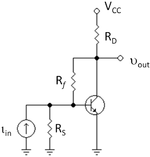Return ratio
The return ratio of a dependent source in a linear electrical circuit is the negative of the ratio of the current (voltage) returned to the site of the dependent source to the current (voltage) of a replacement independent source. The terms loop gain and return ratio are often used interchangeably; however, they are necessarily equivalent only in the case of a single feedback loop system with unilateral blocks. [1]
Calculating the return ratio
The steps for calculating the return ratio of a source are as follows:[2]
- Set all independent sources to zero.
- Select the dependent source for which the return ratio is sought.
- Place an independent source of the same type (voltage or current) and polarity in parallel with the selected dependent source.
- Move the dependent source to the side of the inserted source and cut the two leads joining the dependent source to the independent source.
- For a voltage source the return ratio is minus the ratio of the voltage across the dependent source divided by the voltage of the independent replacement source.
- For a current source, short-circuit the broken leads of the dependent source. The return ratio is minus the ratio of the resulting short-circuit current to the current of the independent replacement source.
Other methods
The above steps can be implemented in SPICE simulations by replacing non-linear devices by their small-signal model equivalents. These steps are not feasible where dependent sources inside devices are not directly accessible, for example, when SPICE itself is used to generate the small-signal circuit numerically, or when measuring the return ratio experimentally. When small-signal models cannot be used, an added problem is finding how to break a a loop without affecting the bias point and altering the results. Middlebrook[3] and Rosenstark[4] have proposed several methods for experimental evaluation of return ratio (loosely referred to by these authors as simply loop gain), and similar methods have been adapted for use in SPICE by Hurst.[5][6] or Roberts,[7] or Sedra,[8] and especially Tuinenga.[9]
Example: Collector-to-base biased bipolar amplifier
The figure at right shows a bipolar amplifier with feedback bias resistor Rf driven by a Norton signal source. In the tableaux of small-signal circuits, the left panel shows the corresponding small-signal circuit obtained by replacing the transistor with its hybrid-pi model. The objective is to find the return ratio of the dependent current source in this amplifier.[10] To reach the objective, the steps outlined above are followed. The center panel shows the application of these steps up to Step 4, with the dependent source moved to the left of the inserted source of value it, and the leads targeted for cutting marked with an X. The right panel shows the circuit set up for calculation of the return ratio T, which is
The return current is
The feedback current in Rf is found by current division to be:
The base-emitter voltage vπ is then, from Ohm's law:
Consequently,
Application in asymptotic gain model
The overall transresistance gain of this amplifier can be shown to be:
with R1 = RS || rπ and R2 = RD || rO.
This expression can be rewritten in the form used by the asymptotic gain model, which expresses the overall gain of a feedback amplifier in terms of several independent factors that often are more easily derived separately than is the gain itself, and that often provide insight into the circuit. This form is:
where the so-called asymptotic gain G∞ is the gain at infinite gm, namely:
and the so-called feed forward or direct feedthrough G0 is the gain for zero gm, namely:
References
- ↑ Richard R Spencer & Ghausi MS (2003). Introduction to electronic circuit design. Upper Saddle River NJ: Prentice Hall/Pearson Education. ISBN 0-201-36183-3.
- ↑ Paul R. Gray, Hurst P J Lewis S H & Meyer RG (2001). Analysis and design of analog integrated circuits, Fourth Edition. New York: Wiley. ISBN 0-471-32168-0.
- ↑ Middlebrook, RD (1975). "Loop gain in feedback systems 1". Int. J. of Electronics 38 (4): pp. 485-512.
- ↑ Rosenstark, Sol (1984). "Loop gain measurement in feedback amplifiers". Int. J. of Electronics 57 (3): pp.415-421.
- ↑ Hurst, PJ (1991). "Exact simulation of feedback circuit parameters". IEEE Trans. on Circuits and Systems 38 (11): pp.1382-1389.
- ↑ Simulating loop gain. Spectrum Newsletters. Spectrum Software (Spring, 1997). Retrieved on 2011-06-30.
- ↑ Gordon W. Roberts & Sedra AS (1997). SPICE, Second Edition. New York: Oxford University Press, Chapter 8; pp. 256-262. ISBN 0-19-510842-6.
- ↑ Adel S Sedra & Smith KC (2004). Microelectronic circuits, Fifth Edition. New York: Oxford University Press, Example 8.7; pp. 855--859. ISBN 0-19-514251-9.
- ↑ Paul W Tuinenga (1995). SPICE: a guide to circuit simulation and analysis using PSpice, Third Edition. Englewood Cliffs NJ: Prentice-Hall, Chapter 8: Loop gain analysis. ISBN 0134360494.
- ↑ Richard R Spencer & Ghausi MS. “Example 10.7 pp. 723-724”, Reference cited earlier. ISBN 0-201-36183-3.










